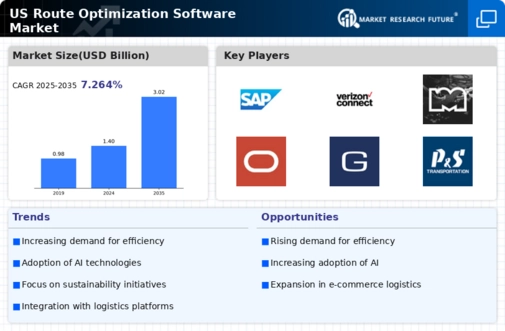The US Route Optimization Software Market is a dynamic and rapidly evolving sector, characterized by intense competition as companies strive to enhance their operational efficiencies through advanced routing solutions. As market demands grow, companies in this space are heavily investing in innovations such as artificial intelligence and machine learning to improve route planning and allocate resources more effectively. The competitive landscape is marked by a proliferation of software solutions that cater to diverse industries, including logistics, transportation, and field service management.
Key players are focusing not only on product differentiation but also on forming strategic partnerships and collaborations to broaden their reach and improve service delivery. As a result, the market is witnessing significant developments in terms of product offerings, customer service enhancements, and technological advancements that aim to optimize routing processes and minimize travel costs, ultimately leading to improved customer satisfaction.In the context of the US Route Optimization Software Market, SAP stands out with its robust portfolio of solutions designed to facilitate superior route planning and logistics management.
SAP integrates advanced analytics and cloud-based technologies into its offerings, which enables organizations to leverage real-time data for more informed decision-making. The strength of SAP lies in its ability to provide comprehensive support across various industry verticals, ensuring that clients can optimize their operations regardless of the complexity of their routing needs. Their focus on scalability and flexibility allows businesses to adapt the software to their unique requirements, enhancing overall functionality and improving efficiency.
Moreover, SAP's established brand presence and reputation for delivering high-quality enterprise solutions solidify its competitive position, enabling it to maintain a strong foothold within the US market.Verizon Connect is another significant player within the US Route Optimization Software Market, providing an array of solutions aimed at streamlining logistics and optimizing fleet management. The company’s key products include GPS tracking systems, field service management tools, and route optimization applications that offer actionable insights for improving operational efficiency. Verizon Connect has a notable market presence, backed by its parent company's vast telecommunications infrastructure, which facilitates reliable service delivery.
The strengths of Verizon Connect include its commitment to innovation, continuous improvement in service capabilities, and strong customer support mechanisms. Furthermore, the company actively explores mergers and acquisitions to expand its market reach and enhance its service offerings. This strategic approach allows Verizon Connect to stay competitive, providing integrated solutions that adapt to the evolving needs of customers in the US Route Optimization Software Market.























